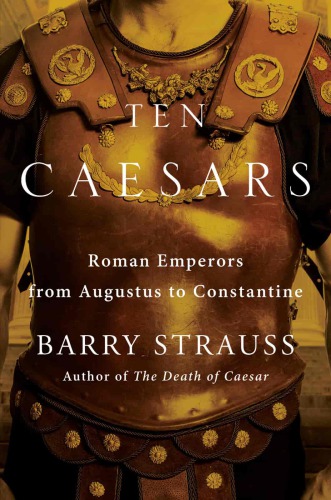
Ten Caesars
Roman Emperors from Augustus to Constantine
کتاب های مرتبط
- اطلاعات
- نقد و بررسی
- دیدگاه کاربران
نقد و بررسی

January 1, 2019
A set of lively biographies of the 10 best-known emperors of Rome.Few educated readers respect many of Hollywood's grandiose versions of events (though HBO's series, Rome, did better), so history buffs will not wince to read about the cruelty, murder, betrayal, and arrogance of even highly regarded emperors. Rocking no boats, Strauss (History and Classics/Cornell Univ.; The Death of Caesar: The Story of History's Most Famous Assassination, 2015, etc.), who has written numerous useful popular books on the classical period, agrees that the ancient Republic was moribund when Julius Caesar delivered the coup de grace. But it took a vicious 20-year civil war before his grand-nephew took power in 27 B.C.E. and proclaimed the restoration of the old Roman Republic; then he gradually assumed the mantel of emperor as Augustus. Historians and contemporaries agree that he did a solid job as emperor, and he was widely mourned at his death. Few historians but Strauss admire his dour successor, Tiberius, who, although a general, avoided war and continued the nearly 200 years of Pax Romana. The author delivers short accounts of all emperors during these years, expanding on the not-always-awful Nero and the admirable Vespasian, Trajan, Hadrian, and ending with Marcus Aurelius, who closed out Rome's golden years. Strauss skims over the disastrous century that followed before concentrating on Diocletian and Constantine, who stabilized the empire mostly through persistent warfare but also reorganized the administration, largely abandoning the city of Rome and the western realm, which vanished a century later, leaving the wealthier eastern Byzantine empire to continue for more than another 1,000 years.Fresh documentary evidence on these times rarely turns up to add to the skimpy surviving chronicles (by Pliny, Tacitus, Cassius Dio, Suetonius et al.), so popular histories have little new ground to break. They must be read for pleasure, and this one delivers good value.
COPYRIGHT(2019) Kirkus Reviews, ALL RIGHTS RESERVED.

February 1, 2019
The Roman Empire required, by necessity, an emperor, but the men who filled that role and how the imperial concept played out varied over time. Strauss (history, Cornell Univ.; The Death of Caesar) highlights ten emperors from various points in Roman history to emphasize their important personality traits and approaches to governing. What is difficult in this presentation is that without the larger context of the emperors surrounding the chosen ten, it ultimately feels like a recitation of all Roman emperors and their military exploits. In taking this tack, a potentially unique perspective gets buried. In particular, the women who were instrumental to the emperors' success and the imperial interactions with the Jews of the Roman Empire are strong content areas that do not receive enough focus. Mary Beard's SPQR: A History of Ancient Rome handles a similar approach with more nuance while still remaining accessible. VERDICT Good for general readers looking for a guide to Roman emperors with some nods to pop psychology and pop culture, but not the most beneficial for specialists.--Margaret Heller, Loyola Univ. Chicago Libs.
Copyright 2019 Library Journal, LLC Used with permission.

























دیدگاه کاربران